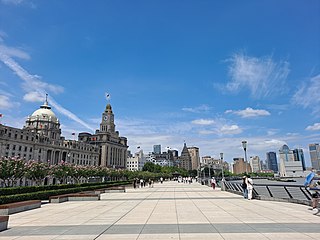
Back Набярэжная Вайтань Byelorussian The Bund Czech Bund (Shanghai) Danish The Bund German Bund (Ŝanhajo) Esperanto Bund Spanish Bund (Shanghai) Basque باند (شانگهای) Persian The Bund Finnish Bund (Shanghai) French

| The Bund | |||||||||||||
|---|---|---|---|---|---|---|---|---|---|---|---|---|---|
 "The Bund" in Simplified (top) and Traditional (bottom) Chinese characters | |||||||||||||
| Simplified Chinese | 外滩 | ||||||||||||
| Traditional Chinese | 外灘 | ||||||||||||
| Literal meaning | "Outer Beach" | ||||||||||||
| |||||||||||||

The Bund[a] is a waterfront area and a protected historical district in central Shanghai. The area centers on a section of Zhongshan Road (East Zhongshan Road No.1) within the former Shanghai International Settlement, which runs along the western bank of the Huangpu River in the eastern part of Huangpu. The area along the river faces the modern skyscrapers of Lujiazui in Pudong. The Bund usually refers to the buildings and wharves on this section of the road, as well as some adjacent areas. This region has a significant European influence, with the style of many structures most comparable to that of European cities, particularly Gothic, Baroque, Neoclassical, Romanesque, Art Deco, and Renaissance architecture. Additionally, some of the city's top eateries are located there.[1] From the 1860s to the 1930s, it was the rich and powerful center of the foreign establishment in Shanghai, operating as a legally protected treaty port.
Cite error: There are <ref group=lower-alpha> tags or {{efn}} templates on this page, but the references will not show without a {{reflist|group=lower-alpha}} template or {{notelist}} template (see the help page).
- ^ Waheed, Abdul Muqeet (2022-12-29). "Best Places to Visit in Shanghai – China Travel Guide". Top Travel Advice. Retrieved 2023-05-23.